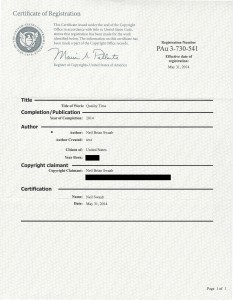With AI (Artificial Intelligence) so prominent these days, it’s easy to feel like the sky…
Copyright 101
As an illustrator, copyrighting your work is incredibly important. It provides a number of unique benefits and is relatively inexpensive. Unfortunately, it’s also misunderstood by a great number of people. The following highlights some basic information about copyright that every illustrator should know:
Your work is copyrighted the moment it’s created
You don’t need to register your work with the copyright office in order for it to have copyright protection. It’s actually copyrighted the moment it’s created and fixed in a tangible form. However, unless it’s registered, you won’t be eligible for certain benefits copyright grants you or be able to file an infringement lawsuit.
Registering with the copyright office is important because:
-

Example copyright certificate from a recent project. It establishes a public record of copyright.
- You’ll receive an official certificate to prove ownership.
- If someone infringes on your work and you win a lawsuit, you’ll be able to collect statutory damages and attorney’s fees. (Without official registration, you won’t be able to.)
- Registration within five years of publication can be used as prima facie evidence in court.
Register early and often
The most protection is granted to you if you register within three months of first publication. While you can register after that window, should someone infringe on your work between that time, you might run into issues collecting statutory damages or lawyers fees. It’s recommended to register your work four times a year (every three months) for the best protection.
Only certain things are copyrightable
Not everything is copyrightable—it only applies to fixed, tangible things. Some things that can’t be copyrighted are:
Names
Book names, band names, character names—none of that stuff can be copyrighted. If the name is important enough, it would need to be trademarked, which is an entirely different protection.
Ideas
Copyright only protects the expression of an idea, not the idea itself. Having a brilliant idea is meaningless in the eyes of the law, it’s all about the execution of it. For instance, a concept for an illustration is not copyrightable, but the actual drawing is.
Methods of operation
The way you do something can’t be copyrighted. So, for an illustrator, that might mean something like technique. It’s not about how you make something, it’s about what you make.
Things that can be copyrighted are original works of authorship including literary, dramatic, musical, and artistic works like illustrations, novels, movies, songs, architecture, and computer software.
Your copyright is protected in countries outside of the U.S.
Your work isn’t just protected here, but in any country that has a copyright treaty with the U.S. A full list of protected countries is available online.
You don’t need to live in the U.S. to register your work with the U.S. copyright office
It doesn’t matter where you live, any work that is protected by U.S. copyright law—including that of a foreign origin— can be registered with the U.S. copyright office.
Your copyright lasts well after you’re dead
Once registered, your copyright will be good for the life of the author plus an additional 70 years, at which point it will enter into Public Domain. If it’s an anonymous work, a pseudonymous work, or a work for hire, it lasts for 95 years from the first publication date or 120 years from the year of its creation—whichever expires first. If it was created prior to 1978, the time varies as there are some different laws that affect its status due to Mickey Mouse.
Copyrighting your work is relatively cheap
It only costs $35 to register a work through the copyright office’s online eCO service for a single application or $55 for a standard application. A batch of work, though, can be copyrighted in an individual group registration for a single fee if it’s been published before and meets some basic requirements or if it’s unpublished and can be identified as a collection.
Copyrighting your work is easy
For most registrations, copyright can be filed simply by using the copyright office’s online eCO service and uploading your work. It takes less than twenty minutes. For more complicated registrations, there are forms to download and physical copies to mail. The copyright office also has an amazing FAQs page and website that will tell you everything you need to know in simple, plain language. Seriously, it’s great and most of the information for this post came directly from it.
Final thoughts
There are clearly some major benefits to copyrighting your work. It’s important to get into the habit of doing it regularly, particularly if you’re putting your stuff on the web where anyone can grab it. Should you have any questions, the copyright office’s web page is the go-to place. You can also call them to talk over any issues directly if you need to. So, do it now, do it frequently, and feel good knowing your work is officially protected.
Comments (0)